Ceramic-metal crowns
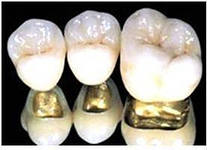
Ceramic-metal crowns are one of the types of dental crowns used in prosthetics, the advantages of which are aesthetics, high strength and affordable cost.
Cermet crowns consist of a cast metal frame covered on top with a ceramic mass.
Types of metal-ceramic crowns
Cermet crowns inside have a cast metal frame. The type of cermet crown depends on what metal the frame is made of.
The thickness of the metal frame is from 0.3 - 0.5 mm. As a result, the thickness of the ceramic-metal crown will be 1.5 - 2.0 mm, because the frame will be covered with ceramic mass on top.
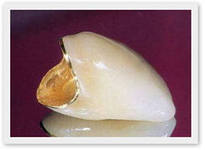
- The frame of the ceramic-metal crown is made of metal or alloys.
- Cobalt-chrome and nickel-chrome alloys are designed specifically for dental prosthetics. However, precious metals or their alloys are often used to make crowns: palladium, platinum, gold.
- The manufacture of metal-ceramic crowns on a gold frame has advantages: finished crowns have a more natural look, which allows you to install metal-ceramic crowns on your front teeth.
Stages of manufacturing ceramic-metal crowns
Traditionally, cermet crowns are made in several stages:
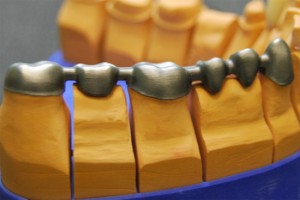
- Preparation of a tooth for prosthetics - tooth treatment, removal of old poor-quality fillings and restorations of teeth and root canals. Removing damaged tooth tissue.
- Preparation for a ceramic-metal crown is carried out with anesthesia. The tooth is sharpened with the creation of a gingival ledge, on which the tooth crown will rest.
- Taking a mold from both jaws of the patient and sending him to the laboratory.
- Making a cast frame from metal.
- Application of ceramic mass to the finished frame. Ceramics are applied in layers. After applying each layer, the crown is fired at a temperature of 800 - 950 degrees in a special furnace. Thus, a very strong bond of metal with ceramics is achieved.
- Trying on a finished crown for a tooth.
- The final selection of the color of the crown with further coating with glaze.
- Installation of a permanent dental structure.
The term for manufacturing ceramic-metal crowns is on average ten days.
Indications for installation
Indications for prosthetics with ceramic-metal crowns:
- Tooth decay, more than half.
- Tooth decay, even if the process has affected the area of the tooth below the level of the gums.
- Lack of one or more teeth.
- The use of teeth as supporting.
- Defects in the dentition will eliminate ceramic-metal crowns on chewing teeth.
- Making crowns on pins.
- Production of artificial teeth on implants.
Contraindications
The installation of ceramic-metal crowns is contraindicated if the patient:
- Chronic periodontitis.
- Mental disorders.
- The presence of pregnancy.
- Bruxism (gnashing of teeth at night).
- The bite is broken.
- The presence of an inflammatory process in the oral cavity.
- The body is weakened after an illness.
How is the installation
Before the start of prosthetics, a complete sanitation of the oral cavity is necessary (treatment of caries, canal filling, removal of old poor-quality fillings).
Prosthetics with ceramic-metal crowns are carried out in several stages:
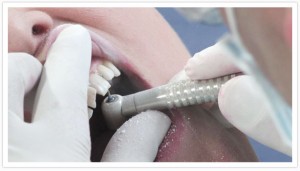
- Tooth preparation. Hard tooth tissues are grinded to the thickness of the future crown. If necessary, a tooth is removed.
- Taking impressions from the jaws of the patient.
- Making a model of teeth from gypsum in a laboratory.
- Making temporary plastic crowns and fixing them on the prepared teeth.
- Production of a cast metal frame of the future crown and its fitting.
- Ceramic metal frame coating.
- Processing a tooth with a special paste containing fluorine to protect the tooth from decay under the crown.
- Installation of the finished structure and fixation on temporary cement. This is necessary so that, in the event of any non-compliance, it is possible to correct it.
- Fixing crowns to permanent cement.
Recovery and rehabilitation
After prosthetics with cermet, unpleasant consequences sometimes arise:
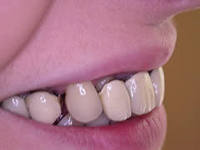
- Inconsistency of the shade of the ceramic-metal crown with the color of the teeth.
- Poor fit of the crown.
- Painful sensations associated with a mismatch in crown size.
- The discomfort.
- Hypersensitivity of teeth.
- Flushing of cement from under the prosthesis or loss of crown, in the case of using low-quality cement.
To avoid complications after installing the design, at first, you need to eat soft food and follow the recommendations of the dentist.
With bruxism, put a mouthguard over your teeth at night.
It is recommended to undergo a professional examination at the dentist at least twice a year.
Video: “Cermet crowns, some features”
FAQ
Today, there is a wide variety of materials for the manufacture of dental crowns. Each of them has advantages and disadvantages.
Answers of specialists to frequently asked questions of patients will help to make the right choice.
- Question: My tooth ached under the crown. The doctor says that you need to remove the crown. How to remove a cermet crown so as not to damage it?
Answer: Remove the crown from cermet so as not to damage it is not always possible. Most often resort to the use of ultrasound. If the tooth hurts under the prosthesis, then removing the crown is not necessary. In some cases, a hole is cut out in the crown and treatment is performed. Then the hole is closed with filling materials.
- Question: I went to the doctor about a toothache. I took an x-ray, an inflammatory process was discovered in the root of the tooth under the crown. Tell me, please, is a ceramic-metal crowns warranty replaced?
Answer: Yes, you have the opportunity to cure your tooth for free and put on a new cermet crown.
- Question: Is it possible to grind a ceramic-metal crown?
Answer: No, the ceramic-metal crown, like other dental crowns, does not grind. Teeth are ground for their installation.
- Question: I want to put crowns on chewing teeth. Which are better: zirconium crowns or cermets?
Answer: On chewing teeth, you can put both zirconium crowns and cermets. Zirconium crowns are more comfortable and have no contraindications. In some cases, an allergy to ceramic-metal crowns is possible.
- Question: The dentist suggested putting ceramic-metal crowns on the front teeth.Tell me which ceramic-metal crowns are better?
Answer: On the front teeth, it is better to put crowns, the frame of which is made of gold. Such crowns are hypoallergenic and more aesthetic.
Pros and cons of ceramic-metal crowns
Advantages of metal-ceramic crowns:
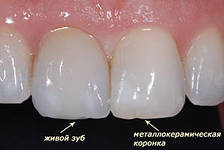
- Comfort and full functionality.
- Good aesthetics.
- Crowns have sufficient strength, as a result of which cermet has a long service life.
- Hygiene Cermet crowns are not affected by bacteria and microorganisms.
- Biological compatibility. Qualitatively established crowns do not cause pathological changes in the gums.
- Ceramic-metal crown with shoulder mass It has some advantages: there is no blackening of the gums near the neck of the tooth, metal is not visible, it is stronger and more durable.
- The possibility of prosthetics, both front teeth and chewing.
- The color of the crown does not change.
- More affordable, compared, for example, with implants.
- The ability to repair ceramic chips directly in the oral cavity.
- Durability, wear resistance, long service life.
Cons of metal-ceramic crowns:
- Chips of ceramic mass are possible.
- The need for strong tooth grinding.
- Mandatory tooth removal in most cases.
Care for ceramic-metal crowns

- Caring for cermets is normal, like real teeth.
- It is enough to conduct oral hygiene twice a day.
- Ceramic-metal constructions should be protected from damage. Do not bite hard objects with teeth made of cermets, because as a result, chips and cracks will appear on the ceramic coating, and they can cause damage to the prosthesis.
Prices for cermet crowns
Crowns on teeth, especially metal ceramics, are very popular today, the price at which consists of the following factors:
- A type of metal or alloy used to make the frame.
- The quality of the ceramic mass.
- Type and cost of dental cement.
- Cost of work of a dentist and dental technician.
The cost of a ceramic-metal crown in Moscow may differ from the cost in other regions.
Since in the process of prosthetics the patient will need temporary crowns. That cost of work increases from 1000 - 1200 rubles for each crown.
| Type of crown | Cost in rubles for 1 crown |
| Cermet Cobalt - Chrome Alloy Crown | From 4500 |
| Ceramic crown for gold - palladium alloy | From 17000 |
Life time
The service life of ceramic-metal crowns depends on the quality of the following work:
- Preparing the tooth for the installation of the crown. If the tooth was not completely cured, then repeated tooth treatment and prosthetics may be required.
- The quality of the dentist’s work: tooth grinding, casting, installation of dental structures. Depends on their quality performance, whether wearing crowns will be comfortable.
- High-quality production of crowns. Aesthetics and durability of structures depend on this factor.
Today, cermets are one of the durable types of dental structures used in prosthetics.
If the crown made of cermet is made in compliance with modern technologies, then the service life of such prostheses is from 10 to 15 years.
A quality ceramic-metal crown can last for decades.
In clinics, they usually give a 1 year warranty on dental prosthetics.
Before the end of the warranty period, you can take x-rays (preferably in another clinic). If pathology is detected at the installation site, then retreatment and repeated prosthetics should be done at the expense of the clinic.
Reviews after installing ceramic-metal crowns
Reviews about the installed ceramic-metal crowns directly depend on the quality of the dentist, orthopedist and dental technician.
- I put recently, crowns for 4 teeth. The teeth were crooked, but absolutely healthy. I was very complex and put them, probably out of stupidity. Now I'm very sorry about that. It seems to me that the ceramic-metal crowns are darkening, the color is not the same as that of other teeth. And there is something wrong with the gums.
- I put a ceramic-metal crown on one tooth. A year has passed after installation. Now the tooth hurts under ceramic-metal crown. Warranty is already over. Doctors say that you need to remove the crown and treat the tooth.
- I have a cermet crown on my two front teeth. I feel great. Others do not notice that the teeth are not real. Color matched perfectly. Desna has a slightly bluish color, but this does not bother me.
- There used to be metal crowns. Already six months worth of cermet. Outwardly, everything is fine, but the ceramic-metal crown interferes while eating.
Photos before and after the installation of ceramic-metal crowns
 |
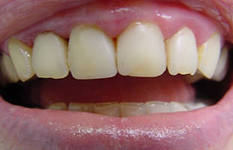 |
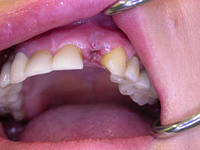 |
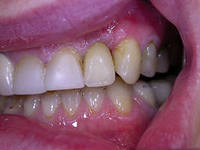 |
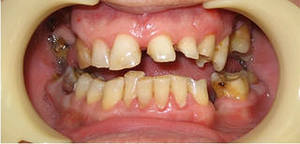 |
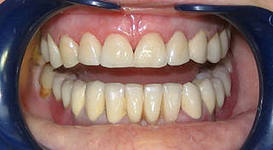 |
